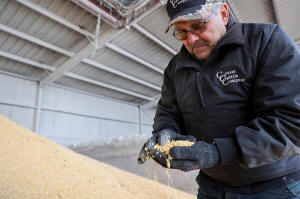Iowa's drought conditions have farmers budgeting water use
 Send a link to a friend
Send a link to a friend
 [March 22, 2024]
By P.J. Huffstutter [March 22, 2024]
By P.J. Huffstutter
CHICAGO (Reuters) - As Iowa heads toward its fourth year of drought,
grain farmers prepping for planting next month are facing mandatory
water restrictions and livestock producers are searching for supplies.
The nation's top corn-producing state is seeing one of its driest
periods going into a growing season, according to Thursday's update from
U.S. Drought Monitor.
Such dry conditions will allow farmers to plant quickly this season, a
bearish move for grain futures that have already been trending downward
this year. The U.S. last year harvested a record corn crop despite
drought conditions in some areas, and corn prices have hovered around
the lowest in more than three years due to plentiful global supply.
Iowa had enough sub-soil moisture that farmers were able to produce a
bountiful yield last fall with timely rains, said Don Roose, president
of Iowa-based U.S. Commodities.
"This year, we're running on empty, moisture-wise," Roose said.

About 23% of Iowa's corn acres and 19% of its soybean acres are in an
extreme drought, according to Gro Intelligence, a New York-based data
and analytics firm that analyzed Thursday's drought update and U.S.
Department of Agriculture data for Reuters.
In comparison, less than 2% of the state's corn and soybean acres were
in an extreme drought during the same time a year earlier, Gro
Intelligence found.
Though forecasts for spring rains could temporarily improve Iowa's
situation, weather models predict that drought conditions in northern
and eastern parts of the state will intensify going into the summer,
said Brad Pugh at the National Weather Service's (NWS) Climate
Prediction Center.
[to top of second column]
|

Bill Couser, a cattle and grain farmer, inspects corn used as feed
for his cows on his farm, in Nevada, Iowa, U.S., January 13, 2024.
REUTERS/Evan Garcia/File Photo

Drought concerns prompted Iowa's Poweshiek Water Association to
issue a mandatory water conservation order this month to customers
in eight counties and surrounding areas.
Among other things, it warned that, starting April 1, crop farmers
wanting to spray diluted chemicals or other inputs on their fields
may need to source water from private wells or outside the service
area.
That order will impact Cordt Holub. Last year, his cattle were able
to drink at a nearby stream - until it ran dry. Water restrictions
could mean shifting his crop farming practices later this season,
which may impact yields.
"Come summertime, if the water isn't there, we're going to have to
skip on a fungicide pass, maybe an insecticide pass," Holub said.
"We need water to farm."
NWS scientists also are tracking how a potential shift to a La Nina
weather pattern this summer may impact interior river levels this
fall - when U.S. grain harvests hit the global markets.
(Reporting By P.J. Huffstutter in Chicago.; Editing by Marguerita
Choy)
[© 2024 Thomson Reuters. All rights reserved.]This material
may not be published, broadcast, rewritten or redistributed.
Thompson Reuters is solely responsible for this content.
 |